Alex Constantine - February 16, 2011
Fascinating Fascism
by Susan Sontag
New York Review of Books
February 6, 1975
republished in:
Under the Sign of Saturn
(New York, 1980), pp. 73-105.
The Last of the Nuba by Leni Riefenstahl (1974)
SS Regalia by Jack Pia (1974)
I
First Exhibit. Here is a book of 126 splendid color photographs by Leni Riefenstahl, certainly the most ravishing book of photographs published anywhere in recent years. In the intractable mountains of the southern Sudan live about eight thousand aloof, godlike Nuba, emblems of physical perfection, with large, well-shaped, partly shaven heads, expressive faces, and muscular bodies that are depilated and decorated with scars; smeared with sacred gray-white ash, the men prance, squat, brood, wrestle on the arid slopes. And here is a fascinating layout of twelve black-and-white photographs of Riefenstahl on the back cover of The Last of the Nuba, also ravishing, a chronological sequence of expressions (from sultry inwardness to the grin of a Texas matron on safari) vanquishing the intractable march of aging. The first photograph was taken in 1927 when she was twenty-five and already a movie star, the most recent are dated 1969 (she is cuddling a naked African baby) and 1972 (she is holding a camera), and each of them shows some version of an ideal presence, a kind of imperishable beauty, like Elisabeth Schwarzkopf's, that only gets gayer and more metallic and healthier-looking with old age. And here is a biographical sketch of Riefenstahl on the dust jacket, and an introduction (unsigned) entitled "How Leni Riefenstahl came to study the Mesakin Nuba of Kordofain"—full of disquieting lies.
The introduction, which gives a detailed account of Riefenstahl's pilgrimage to the Sudan (inspired, we are told, by reading Hemingway's The Green Hills of Africa "one sleepless night in the mid-1950s"), laconically identifies the photographer as "something of a mythical figure as a film-maker before the war, half-forgotten by a nation which chose to wipe from its memory an era of its history." Who (one hopes) but Riefenstahl herself could have thought up this fable about what is mistily referred to as "a nation" which for some unnamed reason "chose" to perform the deplorable act of cowardice of forgetting "an era"—tactfully left unspecified—"of its history"? Presumably, at least some readers will be startled by this coy allusion to Germany and the Third Reich.
Compared with the introduction, the jacket of the book is positively expansive on the subject of the photographer's career, parroting misinformation that Riefenstahl has been dispensing for the last twenty years.
It was during Germany's blighted and momentous 1930s that Leni Riefenstahl sprang to international fame as a film director. She was born in 1902, and her first devotion was to creative dancing. This led to her participation in silent films, and soon she was herself making—and starring in—her own talkies, such as The Mountain (1929).
These tensely romantic productions were widely admired, not least by Adolf Hitler who, having attained power in 1933, commissioned Riefenstahl to make a documentary on the Nuremberg Rally in 1934.
It takes a certain originality to describe the Nazi era as "Germany's blighted and momentous 1930s," to summarize the events of 1933 as Hitler's "having attained power," and to assert that Riefenstahl, most of whose work was in its own decade correctly identified as Nazi propaganda, enjoyed "international fame as a film director," ostensibly like her contemporaries Renoir, Lubitsch, and Flaherty. (Could the publishers have let LR write the jacket copy herself? One hesitates to entertain so unkind a thought, although "her first devotion was to creative dancing" is a phrase few native speakers of English would be capable of.)
The facts are, of course, inaccurate or invented. Not only did Riefenstahl not make—or star in—a talkie called The Mountain (1929). No such film exists. More generally: Riefenstahl did not first simply participate in silent films and then, when sound came in, begin directing and starring in her own films. In all nine films she ever acted in, Riefenstahl was the star; and seven of these she did not direct. These seven films were: The Holy Mountain (Der heilige Berg, 1926), The Big Jump (Der grosse Sprung, 1927), The Fate of the House of Habsburg (Das Schicksal derer von Habsburg, 1929), The White Hell of Pitz Palü (Die weisse Hölle von Piz Palü, 1929)—all silents—followed by Avalanche (Stürme über dem Montblanc, 1930), White Frenzy (Der weisse Rausch, 1931), and S.O.S. Iceberg (S.O.S. Eisberg, 1932-1933). All but one were directed by Arnold Fanck, auteur of hugely successful Alpine epics since 1919, who made only two more films, both flops, after Riefenstahl left him to strike out on her own as a director in 1932. (The film not directed by Fanck is The Fate of the House of Habsburg, a royalist weepie made in Austria in which Riefenstahl played Marie Vetsera, Crown Prince Rudolf's companion at Mayerling. No print seems to have survived.)
Fanck's pop-Wagnerian vehicles for Riefenstahl were not just "tensely romantic." No doubt thought of as apolitical when they were made, these films now seem in retrospect, as Siegfried Kracauer has pointed out, to be an anthology of proto-Nazi sentiments. Mountain climbing in Fanck's films was a visually irresistible metaphor for unlimited aspiration toward the high mystic goal, both beautiful and terrifying, which was later to become concrete in Führer-worship. The character that Riefenstahl generally played was that of a wild girl who dares to scale the peak that others, the "valley pigs," shrink from. In her first role, in the silent The Holy Mountain (1926), that of a young dancer named Diotima, she is wooed by an ardent climber who converts her to the healthy ecstasies of Alpinism. This character underwent a steady aggrandizement. In her first sound film, Avalanche (1930), Riefenstahl is a mountain-possessed girl in love with a young meteorologist, whom she rescues when a storm strands him in his observatory on Mont Blanc.
Riefenstahl herself directed six films, the first of which, The Blue Light (Das blaue Licht, 1932), was another mountain film. Starring in it as well, Riefenstahl played a role similar to the ones in Fanck's films for which she had been so "widely admired, not least by Adolf Hitler," but allegorizing the dark themes of longing, purity, and death that Fanck had treated rather scoutishly. As usual, the mountain is represented as both supremely beautiful and dangerous, that majestic force which invites the ultimate affirmation of and escape from the self—into the brotherhood of courage and into death. The role Riefenstahl devised for herself is that of a primitive creature who has a unique relation to a destructive power: only Junta, the rag-clad outcast girl of the village, is able to reach the mysterious blue light radiating from the peak of Mount Cristallo, while other young villagers, lured by the light, try to climb the mountain and fall to their deaths. What eventually causes the girl's death is not the impossibility of the goal symbolized by the mountain but the materialist, prosaic spirit of envious villagers and the blind rationalism of her lover, a well-meaning visitor from the city.
The next film Riefenstahl directed after The Blue Light was not "a documentary on the Nuremberg Rally in 1934"—Riefenstahl made four non-fiction films, not two, as she has claimed since the 1950s and as most current white-washing accounts of her repeat—but Victory of the Faith (Sieg des Glaubens, 1933), celebrating the first National Socialist Party Congress held after Hitler seized power. Then came the first of two works which did indeed make her internationally famous, the film on the next National Socialist Party Congress, Triumph of the Will (Triumph des Willens, 1935)—whose title is never mentioned on the jacket of The Last of the Nuba—after which she made a short film (eighteen minutes) for the army,
| Day of Freedom on YouTube: Part I 8:55; Part II 7:59 -- at pt. I, min 7 the war games start; throughout are the same signature camera angles etc. as in Triumph and Olympia |
Day of Freedom: Our Army (Tag der Freiheit: Unsere Wehrmacht, 1935), that depicts the beauty of soldiers and soldiering for the Führer. (It is not surprising to find no mention of this film, a print of which was found in 1971; during the 1950s and 1960s, when Riefenstahl and everyone else believed Day of Freedom to have been lost, she had it dropped from her filmography and refused to discuss it with interviewers.)
The jacket copy continues:
Riefenstahl's refusal to submit to Goebbels' attempt to subject her visualisation to his strictly propagandistic requirements led to a battle of wills which came to a head when Riefenstahl made her film of the 1936 Olympic Games, Olympia. This, Goebbels attempted to destroy; and it was only saved by the personal intervention of Hitler.
With two of the most remarkable documentaries of the 1930s to her credit, Riefenstahl continued making films of her devising, unconnected with the rise of Nazi Germany, until 1941, when war conditions made it impossible to continue.
Her acquaintance with the Nazi leadership led to her arrest at the end of the Second World War: she was tried twice, and acquitted twice. Her reputation was in eclipse, and she was half forgotten--although to a whole generation of Germans her name had been a household word.
Except for the bit about her having once been a household word in Nazi Germany, not one part of the above is true. To cast Riefenstahl in the role of the individualist-artist, defying philistine bureaucrats and censorship by the patron state ("Goebbels' attempt to subject her visualisation to his strictly propagandistic requirements") should seem like nonsense to anyone who has seen Triumph of the Will—a film whose very conception negates the possibility of the filmmaker's having an aesthetic conception independent of propaganda. The facts, denied by Riefenstahl since the war, are that she made Triumph of the Will with unlimited facilities and unstinting official cooperation (there was never any struggle between the filmmaker and the German minister of propaganda). Indeed, Riefenstahl was, as she relates in the short book about the making of Triumph of the Will, in on the planning of the rally—which was from the start conceived as the set of a film spectacle.[1]
| [1] Leni Riefenstahl, Hinter den Kulissen des Reichparteitag-Films (Munich, 1935). A photograph on page 31 shows Hitler and Riefenstahl bending over some plans, with the caption: "The preparations for the Party Congress were made hand in hand with the preparations for the camera work." The rally was held on September 4‑10; Riefenstahl relates that she began work in May, planning the film sequence by sequence, and supervising the construction of elaborate bridges, towers, and tracks for the cameras. In late August, Hitler came to Nuremberg with Viktor Lutze, head of the SA, "for an inspection and to give final instructions." Her thirty-two cameramen were dressed in SA uniforms throughout the shooting, "a suggestion of the Chief of Staff [Lutze], so that no one will disturb the solemnity of the image with his civilian clothing." The SS supplied a team of guards. |
| [2] See Hans Barkhausen, "Footnote to the History of Riefenstahl's ‘Olympia,’" Film Quarterly, Fall 1974—a rare act of informed dissent amid the large number of tributes to Riefenstahl that have appeared in American and Western European film magazines during the last few years. |
Olympia—a three-and-a-half-hour film in two parts, Festival of the People (Fest der Völker) and Festival of Beauty (Fest der Schönheit)—was no less an official production. Riefenstahl has maintained in interviews since the 1950s that Olympia was commissioned by the International Olympic Committee, produced by her own company, and made over Goebbels's protests. The truth is that Olympia was commissioned and entirely financed by the Nazi government (a dummy company was set up in Riefenstahl's name because it was thought unwise for the government to appear as the producer) and facilitated by Goebbels's ministry at every stage of the shooting;[2] even the plausible-sounding legend of Goebbels objecting to her footage of the triumphs of the black American track star Jesse Owens is untrue. Riefenstahl worked for eighteen months on the editing, finishing in time so that the film could have its world premiere on April 29, 1938, in Berlin, as part of the festivities for Hitler's forty-ninth birthday; later that year Olympia was the principal German entry at the Venice Film Festival, where it won the Gold Medal.
More lies: to say that Riefenstahl "continued making films of her devising, unconnected with the rise of Nazi Germany, until 1941." In 1939 (after returning from a visit to Hollywood, the guest of Walt Disney), she accompanied the invading Wehrmacht into Poland as a uniformed army war correspondent with her own camera team; but there is no record of any of this material surviving the war. After Olympia Riefenstahl made exactly one more film, Tiefland (Lowland), which she began in 1941—and, after an interruption, resumed in 1944 (in the Barrandov Film Studios in Nazi-occupied Prague), and finished in 1954. Like The Blue Light, Tiefland opposes lowland or valley corruption to mountain purity, and once again the protagonist (played by Riefenstahl) is a beautiful outcast. Riefenstahl prefers to give the impression that there were only two documentaries in a long career as a director of fiction films, but the truth is that four of the six films she directed were documentaries made for and financed by the Nazi government.
It is hardly accurate to describe Riefenstahl's professional relationship to and intimacy with Hitler and Goebbels as "her acquaintance with the Nazi leadership." Riefenstahl was a close friend and companion of Hitler's well before 1932; she was a friend of Goebbels, too: no evidence supports Riefenstahl's persistent claim since the 1950s that Goebbels hated her, or even that he had the power to interfere with her work. Because of her unlimited personal access to Hitler, Riefenstahl was precisely the only German filmmaker who was not responsible to the Film Office (Reichsfilmkammer) of Goebbels's ministry of propaganda. Last, it is misleading to say that Riefenstahl was "tried twice, and acquitted twice" after the war. What happened is that she was briefly arrested by the Allies in 1945 and two of her houses (in Berlin and Munich) were seized. Examinations and court appearances started in 1948, continuing intermittently until 1952, when she was finally "de-Nazified" with the verdict: "No political activity in support of the Nazi regime which would warrant punishment." More important: whether or not Riefenstahl deserved a prison sentence, it was not her "acquaintance" with the Nazi leadership but her activities as a leading propagandist for the Third Reich that were at issue.
| [3] If another source is wanted—since Riefenstahl now claims (in an interview in the German magazine Filmkritik, August 1972) that she didn't write a single word of Hinter den Kulissen des Reichparteitag-Films, or even read it at the time—there is an interview in the Völkischer Beobachter, August 26, 1933, about her filming of the 1933 Nuremberg rally, where she makes similar declarations. Riefenstahl and her apologists always talk about Triumph of the Will as if it were an independent "documentary," often citing technical problems encountered while filming to prove she had enemies among the party leadership (Goebbels's hatred), as if such difficulties were not a normal part of filmmaking. One of the more dutiful reruns of the myth of Riefenstahl as mere documentarist—and political innocent—is the Filmguide to "Triumph of the Will" published in the Indiana University Press Filmguide Series, whose author, Richard Meram Barsam, concludes his preface by expressing his "gratitude to Leni Riefenstahl herself, who cooperated in many hours of interviews, opened her archive to my research, and took a genuine interest in this book." Well might she take an interest in a book whose opening chapter is "Leni Riefenstahl and the Burden of Independence," and whose theme is "Riefenstahl's belief that the artist must, at all costs, remain independent of the material world. In her own life, she has achieved artistic freedom, but at a great cost." Etc. As an antidote, let me quote an unimpeachable source (at least he's not here to say he didn't write it)—Adolf Hitler. In his brief preface to Hinter den Kulissen, Hitler describes Triumph of the Will as "a totally unique and incomparable glorification of the power and beauty of our Movement." And it is. |
The jacket copy of The Last of the Nuba summarizes faithfully the main line of the self-vindication which Riefenstahl fabricated in the 1950s and which is most fully spelled out in the interview she gave to Cahiers du Cinéma in September 1965. There she denied that any of her work was propaganda—calling it cinema verité. "Not a single scene is staged," Riefenstahl says of Triumph of the Will. "Everything is genuine. And there is no tendentious commentary for the simple reason that there is no commentary at all. It is history—pure history." We are a long way from that vehement disdain for "the chronicle-film," mere "reportage" or "filmed facts," as being unworthy of the event's "heroic style" which is expressed in her book on the making of the film.[3]
Although Triumph of the Will has no narrative voice, it does open with a written text heralding the rally as the redemptive culmination of German history. But this opening statement is the least original of the ways in which the film is tendentious. It has no commentary because it doesn't need one, for Triumph of the Will represents an already achieved and radical transformation of reality: history become theater. How the 1934 Party convention was staged was partly determined by the decision to produce Triumph of the Will—the historic event serving as the set of a film which was then to assume the character of an authentic documentary. Indeed, when some of the footage of Party leaders at the speakers' rostrum was spoiled, Hitler gave orders for the shots to be refilmed; and Streicher, Rosenberg, Hess, and Frank histrionically repledged their fealty to the Führer weeks later, without Hitler and without an audience, on a studio set built by Speer. (It is altogether correct that Speer, who built the gigantic site of the rally on the outskirts of Nuremberg, is listed in the credits of Triumph of the Will as architect of the film.) Anyone who defends Riefenstabl's films as documentaries, if documentary is to be distinguished from propaganda, is being ingenuous. In Triumph of the Will, the document (the image) not only is the record of reality but is one reason for which the reality has been constructed, and must eventually supersede it.
The rehabilitation of proscribed figures in liberal societies does not happen with the sweeping bureaucratic finality of the Soviet Encyclopedia, each new edition of which brings forward some hitherto unmentionable figures and lowers an equal or greater number through the trap door of nonexistence. Our rehabilitations are smoother, more insinuative. It is not that Riefenstahl's Nazi past has suddenly become acceptable. It is simply that, with the turn of the cultural wheel, it no longer matters. Instead of dispensing a freeze-dried version of history from above, a liberal society settles such questions by waiting for cycles of taste to distill out the controversy.
The purification of Leni Riefenstahl's reputation of its Nazi dross has been gathering momentum for some time, but it has reached some kind of climax this year, with Riefenstahl the guest of honor at a new cinéphile-controlled film festival held in the summer in Colorado and the subject of a stream of respectful articles and interviews in newspapers and on TV, and now with the publication of The Last of the Nuba. Part of the impetus behind Riefenstahl's recent promotion to the status of a cultural monument surely owes to the fact that she is a woman. The 1973 New York Film Festival poster, made by a well-known artist who is also a feminist, showed a blond doll-woman whose right breast is encircled by three names: Agnès Leni Shirley. (That is, Varda, Riefenstahl, Clarke.) Feminists would feel a pang at having to sacrifice the one woman who made films that everybody acknowledges to be first-rate. But the strongest impetus behind the change in attitude toward Riefenstahl lies in the new, ampler fortunes of the idea of the beautiful.
The line taken by Riefenstahl's defenders, who now include the most influential voices in the avant-garde film establishment, is that she was always concerned with beauty. This, of course, has been Riefenstahl's own contention for some years. Thus the Cahiers du Cinéma interviewer set Riefenstahl up by observing fatuously that what Triumph of the Will and Olympia "have in common is that they both give form to a certain reality, itself based on a certain idea of form. Do you see anything peculiarly German about this concern for form?" To this, Riefenstahl answered:
I can simply say that I feel spontaneously attracted by everything that is beautiful. Yes: beauty, harmony. And perhaps this care for composition, this aspiration to form is in effect something very German. But I don't know these things myself, exactly. It comes from the unconscious and not from my knowledge. . . . What do you want me to add? Whatever is purely realistic, slice-of-life, which is average, quotidian, doesn't interest me.... I am fascinated by what is beautiful, strong, healthy, what is living. I seek harmony. When harmony is produced I am happy. I believe, with this, that I have answered you.
| [4] This is how Jonas Mekas (The Village Voice, October 31, 1974) salutes the publication of The Last of the Nuba: "Riefenstahl continues her celebration—or is it a search?—of the classical beauty of the human body, the search which she began in her films. She is interested in the ideal, in the monumental." Mekas in the same paper on November 7, 1974: "And here is my own final statement on Riefenstahl's films: If you are an idealist, you'll see idealism in her films; if you are a classicist, you'll see in her films an ode to classicism; if you are a Nazi, you'll see in her films Nazism." |
That is why The Last of the Nuba is the last, necessary step in Riefenstahl's rehabilitation. It is the final rewrite of the past; or, for her partisans, the definitive confirmation that she was always a beauty freak rather than a horrid propagandist.[4] Inside the beautifully produced book, photographs of the perfect, noble tribe. And on the jacket, photographs of "my perfect German woman" (as Hitler called Riefenstahl), vanquishing the slights of history, all smiles.
Admittedly, if the book were not signed by Riefenstahl one would not necessarily suspect that these photographs had been taken by the most interesting, talented, and effective artist of the Nazi era. Most people who leaf through The Last of the Nuba will probably see it as one more lament for vanishing primitives—the greatest example remains Lévi-Strauss in Tristes Tropiques on the Bororo Indians in Brazil—but if the photographs are examined carefully, in conjunction with the lengthy text written by Riefenstahl, it becomes clear that they are continuous with her Nazi work. Riefenstahl's particular slant is revealed by her choice of this tribe and not another: a people she describes as acutely artistic (everyone owns a lyre) and beautiful (Nuba men, Riefenstahl notes, "have an athletic build rare in any other African tribe"); endowed as they are with "a much stronger sense of spiritual and religious relations than of worldly and material matters," their principal activity, she insists, is ceremonial. The Last of the Nuba is about a primitivist ideal: a portrait of a people subsisting in a pure harmony with their environment, untouched by "civilization."
All four of Riefenstahl's commissioned Nazi films—whether about Party congresses, the Wehrmacht, or athletes—celebrate the rebirth of the body and of community, mediated through the worship of an irresistible leader. They follow directly from the films of Fanck in which she starred and her own The Blue Light. The Alpine fictions are tales of longing for high places, of the challenge and ordeal of the elemental, the primitive; they are about the vertigo before power, symbolized by the majesty and beauty of mountains. The Nazi films are epics of achieved community, in which everyday reality is transcended through ecstatic self-control and submission; they are about the triumph of power. And The Last of the Nuba, an elegy for the soon-to-be extinguished beauty and mystic powers of primitives whom Riefenstahl calls "her adopted people," is the third in her triptych of fascist visuals.
In the first panel, the mountain films, heavily dressed people strain upward to prove themselves in the purity of the cold; vitality is identified with physical ordeal. For the middle panel, the films made for the Nazi government: Triumph of the Will uses overpopulated wide shots of massed figures alternating with close-ups that isolate a single passion, a single perfect submission: in a temperate zone clean-cut people in uniforms group and regroup, as if they were seeking the perfect choreography to express their fealty. In Olympia, the richest visually of all her films (it uses both the verticals of the mountain films and the horizontal movements characteristic of Triumph of the Will), one straining, scantily clad figure after another seeks the ecstasy of victory, cheered on by ranks of compatriots in the stands, all under the still gaze of the benign Super-Spectator, Hitler, whose presence in the stadium consecrates this effort. (Olympia, which could as well have been called Triumph of the Will, emphasizes that there are no easy victories.) In the third panel, The Last of the Nuba, the almost naked primitives, awaiting the final ordeal of their proud heroic community, their imminent extinction, frolic and pose under the scorching sun.
It is Götterdammerung time. The central events in Nuba society are wrestling matches and funerals: vivid encounters of beautiful male bodies and death. The Nuba, as Riefenstahl interprets them, are a tribe of aesthetes. Like the henna-daubed Masai and the so-called Mudmen of New Guinea, the Nuba paint themselves for all important social and religious occasions, smearing on a white-gray ash which unmistakably suggests death. Riefenstahl claims to have arrived "just in time," for in the few years since these photographs were taken the glorious Nuba have been corrupted by money, jobs, clothes. (And, probably, by war—which Riefenstahl never mentions, since what she cares about is myth not history. The civil war that has been tearing up that part of the Sudan for a dozen years must have scattered new technology and a lot of detritus.)
Although the Nuba are black, not Aryan, Riefenstahl's portrait of them evokes some of the larger themes of Nazi ideology: the contrast between the clean and the impure, the incorruptible and the defiled, the physical and the mental, the joyful and the critical. A principal accusation against the Jews within Nazi Germany was that they were urban, intellectual, bearers of a destructive corrupting "critical spirit." The book bonfire of May 1933 was launched with Goebbels's cry: "The age of extreme Jewish intellectualism has now ended, and the success of the German revolution has again given the right of way to the German spirit." And when Goebbels officially forbade art criticism in November 1936, it was for having "typically Jewish traits of character": putting the head over the heart, the individual over the community, intellect over feeling. In the transformed thematics of latter-day fascism, the Jews no longer play the role of defiler. It is "civilization" itself.
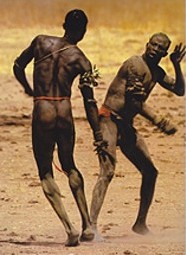 |
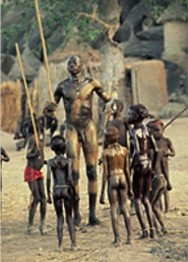 |
What is distinctive about the fascist version of the old idea of the Noble Savage is its contempt for all that is reflective, critical, and pluralistic. In Riefenstahl's casebook of primitive virtue, it is hardly—as in Lévi-Strauss—the intricacy and subtlety of primitive myth, social organization, or thinking that is being extolled. Riefenstahl strongly recalls fascist rhetoric when she celebrates the ways the Nuba are exalted and unified by the physical ordeals of their wrestling matches, in which the "heaving and straining" Nuba men, "huge muscles bulging," throw one another to the ground—fighting not for material prizes but "for the renewal of the sacred vitality of the tribe." Wrestling and the rituals that go with it, in Riefenstahl's account, bind the Nuba together. Wrestling
… is the expression of all that distinguishes the Nuba way of life. … Wrestling generates the most passionate loyalty and emotional participation in the team's supporters, who are, in fact, the entire "non-playing" population of the village. … Its importance as the expression of the total outlook of the Mesakin and Korongo cannot be exaggerated; it is the expression in the visible and social world of the invisible world of the mind and of the spirit.
In celebrating a society where the exhibition of physical skill and courage and the victory of the stronger man over the weaker are, as she sees it, the unifying symbols of the communal culture—where success in fighting is the "main aspiration of a man's life"—Riefenstahl seems hardly to have modified the ideas of her Nazi films. And her portrait of the Nuba goes further than her films in evoking one aspect of the fascist ideal: a society in which women are merely breeders and helpers, excluded from all ceremonial functions, and represent a threat to the integrity and strength of men. From the "spiritual" Nuba point of view (by the Nuba Riefenstahl means, of course, males), contact with women is profane; but, ideal society that this is supposed to be, the women know their place.
The fiancées or wives of the wrestlers are as concerned as the men to avoid any intimate contact … their pride at being the bride or wife of a strong wrestler supersedes their amorousness.
Lastly, Riefenstahl is right on target with her choice as a photographic subject of a people who "look upon death as simply a matter of fate—which they do not resist or struggle against," of a society whose most enthusiastic and lavish ceremonial is the funeral. Viva la muerte.
It may seem ungrateful and rancorous to refuse to cut loose The Last of the Nuba from Riefenstahl's past, but there are salutary lessons to be learned from the continuity of her work as well as from that curious and implacable recent event—her rehabilitation. The careers of other artists who became fascists, such as Céline and Benn and Marinetti and Pound (not to mention those, like Pabst and Pirandello and Hamsun, who embraced fascism in the decline of their powers), are not instructive in a comparable way. For Riefenstahl is the only major artist who was completely identified with the Nazi era and whose work, not only during the Third Reich but thirty years after its fall, has consistently illustrated many themes of fascist aesthetics.
Fascist aesthetics include but go far beyond the rather special celebration of the primitive to be found in The Last of the Nuba. More generally, they flow from (and justify) a preoccupation with situations of control, submissive behavior, extravagant effort, and the endurance of pain; they endorse two seemingly opposite states, egomania and servitude. The relations of domination and enslavement take the form of a characteristic pageantry: the massing of groups of people; the turning of people into things; the multiplication or replication of things; and the grouping of people/things around an all-powerful, hypnotic leader-figure or force. The fascist dramaturgy centers on the orgiastic transactions between mighty forces and their puppets, uniformly garbed and shown in ever swelling numbers. Its choreography alternates between ceaseless motion and a congealed, static, "virile" posing. Fascist art glorifies surrender, it exalts mindlessness, it glamorizes death.
Such art is hardly confined to works labeled as fascist or produced under fascist governments. (To cite films only: Walt Disney's Fantasia, Busby Berkeley's The Gang's All Here, and Kubrick's 2001 also strikingly exemplify certain formal structures and themes of fascist art.) And, of course, features of fascist art proliferate in the official art of communist countries—which always presents itself under the banner of realism, while fascist art scorns realism in the name of "idealism." The tastes for the monumental and for mass obeisance to the hero are common to both fascist and communist art, reflecting the view of all totalitarian regimes that art has the function of "immortalizing" its leaders and doctrines. The rendering of movement in grandiose and rigid patterns is another element in common, for such choreography rehearses the very unity of the polity. The masses are made to take form, be design. Hence mass athletic demonstrations, a choreographed display of bodies, are a valued activity in all totalitarian countries; and the art of the gymnast, so popular now in Eastern Europe, also evokes recurrent features of fascist aesthetics; the holding in or confining of force; military precision.
In both fascist and communist politics, the will is staged publicly, in the drama of the leader and the chorus. What is interesting about the relation between politics and art under National Socialism is not that art was subordinated to political needs, for this is true of dictatorships both of the right and of the left, but that politics appropriated the rhetoric of art—art in its late romantic phase. (Politics is "the highest and most comprehensive art there is," Goebbels said in 1933, "and we who shape modern German policy feel ourselves to be artists . . . the task of art and the artist [being] to form, to give shape, to remove the diseased and create freedom for the healthy.") What is interesting about art under National Socialism are those features which make it a special variant of totalitarian art. The official art of countries like the Soviet Union and China aims to expound and reinforce a utopian morality. Fascist art displays a utopian aesthetics—that of physical perfection. Painters and sculptors under the Nazis often depicted the nude, but they were forbidden to show any bodily imperfections. Their nudes look like pictures in physique magazines: pinups which are both sanctimoniously asexual and (in a technical sense) pornographic, for they have the perfection of a fantasy. Riefenstahl's promotion of the beautiful and the healthy, it must be said, is much more sophisticated than this; and never witless, as it is in other Nazi visual art. She appreciates a range of bodily types—in matters of beauty she is not racist—and in Olympia she does show some effort and strain, with its attendant imperfections, as well as stylized, seemingly effortless exertions (such as diving, in the most admired sequence of the film). [4:53 diving sequence on youtube]
In contrast to the asexual chasteness of official communist art, Nazi art is both prurient and idealizing. A utopian aesthetics (physical perfection; identity as a biological given) implies an ideal eroticism: sexuality converted into the magnetism of leaders and the joy of followers. The fascist ideal is to transform sexual energy into a "spiritual" force, for the benefit of the community. The erotic (that is, women) is always present as a temptation, with the most admirable response being a heroic repression of the sexual impulse. Thus Riefenstahl explains why Nuba marriages, in contrast to their splendid funerals, involve no ceremonies or feasts.
A Nuba man's greatest desire is not union with a woman but to be a good wrestler, thereby affirming the principle of abstemiousness. The Nuba dance ceremonies are not sensual occasions but rather "festivals of chastity"—of containment of the life force.
Fascist aesthetics is based on the containment of vital forces; movements are confined, held tight, held in.
Nazi art is reactionary, defiantly outside the century's mainstream of achievement in the arts. But just for this reason it has been gaining a place in contemporary taste. 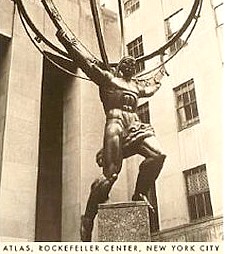 The left-wing organizers of a current exhibition of Nazi painting and sculpture (the first since the war) in Frankfurt have found, to their dismay, the attendance excessively large and hardly as serious-minded as they had hoped. Even when flanked by didactic admonitions from Brecht and by concentration-camp photographs, what Nazi art reminds these crowds of is—other art of the 1930s, notably Art Deco.(Art Nouveau could never be a fascist style; it is, rather, the prototype of that art which fascism defines as decadent; the fascist style at its best is Art Deco, with its sharp lines and blunt massing of material, its petrified eroticism.) The same aesthetic responsible for the bronze colossi of Arno Breker—Hitler's (and, briefly, Cocteau's) favorite sculptor—and of Josef Thorak also produced the muscle-bound Atlas in front of Manhattan's Rockefeller Center and the faintly lewd monument to the fallen doughboys, of World War I in Philadelphia's Thirtieth Street railroad station.
The left-wing organizers of a current exhibition of Nazi painting and sculpture (the first since the war) in Frankfurt have found, to their dismay, the attendance excessively large and hardly as serious-minded as they had hoped. Even when flanked by didactic admonitions from Brecht and by concentration-camp photographs, what Nazi art reminds these crowds of is—other art of the 1930s, notably Art Deco.(Art Nouveau could never be a fascist style; it is, rather, the prototype of that art which fascism defines as decadent; the fascist style at its best is Art Deco, with its sharp lines and blunt massing of material, its petrified eroticism.) The same aesthetic responsible for the bronze colossi of Arno Breker—Hitler's (and, briefly, Cocteau's) favorite sculptor—and of Josef Thorak also produced the muscle-bound Atlas in front of Manhattan's Rockefeller Center and the faintly lewd monument to the fallen doughboys, of World War I in Philadelphia's Thirtieth Street railroad station.
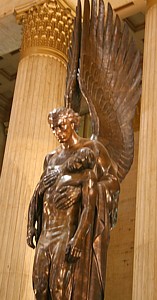 |
| Actually, this is a World War II memorial from 1952. See: philart.net. |
To an unsophisticated public in Germany, the appeal of Nazi art may have been that it was simple, figurative, emotional; not intellectual; a relief from the demanding complexities of modernist art. To a more sophisticated public, the appeal is partly to that avidity which is now bent on retrieving all the styles of the past, especially the most pilloried. But a revival of Nazi art, following the revivals of Art Nouveau, Pre-Raphaelite painting, and Art Deco, is most unlikely. The painting and sculpture are not just sententious; they are astonishingly meager as art. But precisely these qualities invite people to look at Nazi art with knowing and sniggering detachment, as a form of Pop Art.
Riefenstahl's work is free of the amateurism and naïveté one finds in other art produced in the Nazi era, but it still promotes many of the same values. And the same very modern sensibility can appreciate her as well. The ironies of pop sophistication make for a way of looking at Riefenstahl's work in which not only its formal beauty but its political fervor are viewed as a form of aesthetic excess. And alongside this detached appreciation of Riefenstahl is a response, whether conscious or unconscious, to the subject itself, which gives her work its power.
Triumph of the Will and Olympia are undoubtedly superb films (they may be the two greatest documentaries ever made), but they are not really important in the history of cinema as an art form. Nobody making films today alludes to Riefenstahl, while many filmmakers (including myself) regard Dziga Vertov as an inexhaustible provocation and source of ideas about film language. Yet it is arguable that Vertov—the most important figure in documentary films—never made a film as purely effective and thrilling as Triumph of the Will or Olympia. (Of course, Vertov never had the means at his disposal that Riefenstahl bad. The Soviet government's budget for propaganda films in the 1920s and early 1930s was less than lavish.)
In dealing with propagandistic art on the left and on the right, a double standard prevails. Few people would admit that the manipulation of emotion in Vertov's later films and in Riefenstahl's provides similar kinds of exhilaration. When explaining why they are moved, most people are sentimental in the case of Vertov and dishonest in the case of Riefenstahl. Thus Vertov's work evokes a good deal of moral sympathy on the part of his cinéphile audiences all over the world; people consent to be moved. With Riefenstahl's work, the trick is to filter out the noxious political ideology of her films, leaving only their "aesthetic" merits. Praise of Vertov's films always presupposes the knowledge that he was an attractive person and an intelligent and original artist-thinker, eventually crushed by the dictatorship which he served. And most of the contemporary audience for Vertov (as for Eisenstein and Pudovkin) assumes that the film propagandists in the early years of the Soviet Union were illustrating a noble ideal, however much it was betrayed in practice. But praise of Riefenstahl has no such recourse, since nobody, not even her rehabilitators, has managed to make Riefenstahl seem even likable; and she is no thinker at all.
More important, it is generally thought that National Socialism stands only for brutishness and terror. But this is not true. National Socialism—more broadly, fascism—also stands for an ideal or rather ideals that are persistent today under the other banners: the ideal of life as art, the cult of beauty, the fetishism of courage, the dissolution of alienation in ecstatic feelings of community; the repudiation of the intellect; the family of man (under the parenthood of leaders). These ideals are vivid and moving to many people, and it is dishonest as well as tautological to say that one is affected by Triumph of the Will and Olympia only because they were made by a filmmaker of genius. Riefenstahl's films are still effective because, among other reasons, their longings are still felt, because their content is a romantic ideal to which many continue to be attached and which is expressed in such diverse modes of cultural dissidence and propaganda for new forms of community as the youth/rock culture, primal therapy, anti-psychiatry, Third World camp-following, and belief in the occult. The exaltation of community does not preclude the search for absolute leadership; on the contrary, it may inevitably lead to it. (Not surprisingly, a fair number of the young people now prostrating themselves before gurus and submitting to the most grotesquely autocratic discipline are former anti-authoritarians and anti-elitists of the 1960s.)
Riefenstahl's current de-Nazification and vindication as indomitable priestess of the beautiful—as a filmmaker and, now, as a photographer—do not augur well for the keenness of current abilities to detect the fascist longings in our midst. Riefenstahl is hardly the usual sort of aesthete or anthropological romantic. The force of her work being precisely in the continuity of its political and aesthetic ideas, what is interesting is that this was once seen so much more clearly than it seems to be now, when people claim to be drawn to Riefenstahl's images for their beauty of composition. Without a historical perspective, such connoisseurship prepares the way for a curiously absentminded acceptance of propaganda for all sorts of destructive feelings—feelings whose implications people are refusing to take seriously. Somewhere, of course, everyone knows that more than beauty is at stake in art like Riefenstahl's. And so people hedge their bets—admiring this kind of art, for its undoubted beauty, and patronizing it, for its sanctimonious promotion of the beautiful. Backing up the solemn choosy formalist appreciations lies a larger reserve of appreciation, the sensibility of camp, which is unfettered by the scruples of high seriousness: and the modern sensibility relies on continuing trade-offs between the formalist approach and camp taste.
Art which evokes the themes of fascist aesthetic is popular now, and for most people it is probably no more than a variant of camp. Fascism may be merely fashionable, and perhaps fashion with its irrepressible promiscuity of taste will save us. But the judgments of taste themselves seem less innocent. Art that seemed eminently worth defending ten years ago, as a minority or adversary taste, no longer seems defensible today, because the ethical and cultural issues it raises have become serious, even dangerous, in a way they were not then. The hard truth is that what may be acceptable in elite culture may not be acceptable in mass culture, that tastes which pose only innocuous ethical issues as the property of a minority become corrupting when they become more established. Taste is context, and the context has changed.
II
 Second Exhibit. Here is a book to be purchased at airport magazine stands and in "adult" bookstores, a relatively cheap paperback, not an expensive coffee-table item appealing to art lovers and the bien-pensant like The Last of the Nuba. Yet both books share a certain community of moral origin, a root preoccupation: the same preoccupation at different stages of evolution-the ideas that animate The Last of the Nuba being less out of the moral closet than the cruder, more efficient idea that lies behind SS Regalia. Though SS Regalia is a respectable British-made compilation (with a three-page historical preface and notes in the back), one knows that its appeal is not scholarly but sexual. The cover already makes that clear. Across the large black swastika of an SS armband is a diagonal yellow stripe which reads "Over 100 Brilliant Four-Color Photographs Only $2.95," exactly as a sticker with the price on it used to be affixed—part tease, part deference to censorship—on the cover of pornographic magazines, over the model's genitalia. [Oct. 1971 Playboy cover; May 2003 Entertainment Weekly Dixie Chicks Cover]
Second Exhibit. Here is a book to be purchased at airport magazine stands and in "adult" bookstores, a relatively cheap paperback, not an expensive coffee-table item appealing to art lovers and the bien-pensant like The Last of the Nuba. Yet both books share a certain community of moral origin, a root preoccupation: the same preoccupation at different stages of evolution-the ideas that animate The Last of the Nuba being less out of the moral closet than the cruder, more efficient idea that lies behind SS Regalia. Though SS Regalia is a respectable British-made compilation (with a three-page historical preface and notes in the back), one knows that its appeal is not scholarly but sexual. The cover already makes that clear. Across the large black swastika of an SS armband is a diagonal yellow stripe which reads "Over 100 Brilliant Four-Color Photographs Only $2.95," exactly as a sticker with the price on it used to be affixed—part tease, part deference to censorship—on the cover of pornographic magazines, over the model's genitalia. [Oct. 1971 Playboy cover; May 2003 Entertainment Weekly Dixie Chicks Cover]
There is a general fantasy about uniforms. They suggest community, order, identity (through ranks, badges, medals, things which declare who the wearer is and what he has done: his worth is recognized), competence, legitimate authority, the legitimate exercise of violence. But uniforms are not the same thing as photographs of uniforms—which are erotic materials and photographs of SS uniforms are the units of a particularly powerful and widespread sexual fantasy. Why the SS? Because the SS was the ideal incarnation of fascism's overt assertion of the righteousness of violence, the right to have total power over others and to treat them as absolutely inferior. It was in the SS that this assertion seemed most complete, because they acted it out in a singularly brutal and efficient manner; and because they dramatized it by linking themselves to certain aesthetic standards. The SS was designed as an elite military community that would be not only supremely violent but also supremely beautiful. (One is not likely to come across a book called "SA Regalia." The SA, whom the SS replaced, were not known for being any less brutal than their successors, but they have gone down in history as beefy, squat, beerhall types; mere brownshirts.)
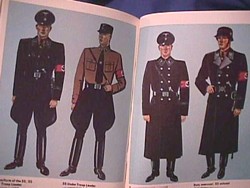 SS uniforms were stylish, well-cut, with a touch (but not too much) of eccentricity. Compare the rather boring and not very well cut American army uniform: jacket, shirt, tie, pants, socks, and lace-up shoes—essentially civilian clothes no matter how bedecked with medals and badges. SS uniforms were tight, heavy, stiff and included gloves to confine the hands and boots that made legs and feet feel heavy, encased, obliging their wearer to stand up straight. As the back cover of SS Regalia explains:
SS uniforms were stylish, well-cut, with a touch (but not too much) of eccentricity. Compare the rather boring and not very well cut American army uniform: jacket, shirt, tie, pants, socks, and lace-up shoes—essentially civilian clothes no matter how bedecked with medals and badges. SS uniforms were tight, heavy, stiff and included gloves to confine the hands and boots that made legs and feet feel heavy, encased, obliging their wearer to stand up straight. As the back cover of SS Regalia explains:
The uniform was black, a colour which had important overtones in Germany. On that, the SS wore a vast variety of decorations, symbols, badges to distinguish rank, from the collar runes to the death's-head. The appearance was both dramatic and menacing.
The cover's almost wistful come-on does not quite prepare one for the banality of most of the photographs. Along with those celebrated black uniforms, SS troopers were issued almost American-army-looking khaki uniforms and camouflage ponchos and jackets. And besides the photographs of uniforms, there are pages of collar patches, cuff bands, chevrons, belt buckles, commemorative badges, regimental standards, trumpet banners, field caps, service medals, shoulder flashes, permits, passes-few of which bear either the notorious runes or the death's-head; all meticulously identified by rank, unit, and year and season of issue. Precisely the innocuousness of practically all of the photographs testifies to the power of the image: one is handling the breviary of a sexual fantasy. For fantasy to have depth, it must have detail. What, for example, was the color of the travel permit an SS sergeant would have needed to get from Trier to Lübeck in the spring of 1944? One needs all the documentary evidence.
If the message of fascism has been neutralized by an aesthetic view of life, its trappings have been sexualized. This eroticization of fascism can be remarked in such enthralling and devout manifestations as Mishima's Confessions of a Mask and Sun and Steel, and in films like Kenneth Anger's Scorpio Rising and, more recently and far less interestingly, in Visconti's The Damned and Cavani's The Night Porter.
The solemn eroticizing of fascism must be distinguished from a sophisticated playing with cultural horror, where there is an element of the put-on. The poster Robert Morris made for his recent show at the Castelli Gallery is a photograph of the artist, naked to the waist, wearing dark glasses, what appears to be a Nazi helmet, and a spiked steel collar, attached to which is a stout chain which he holds in his manacled, uplifted hands. Morris is said to have considered this to be the only image that still has any power to shock: a singular virtue to those who take for granted that art is a sequence of ever-fresh gestures of provocation. But the point of the poster is its own negation. Shocking people in the context also means inuring them, as Nazi material enters the vast repertory of popular iconography usable for the ironic commentaries of Pop Art. Still, Nazism fascinates in a way other iconography staked out by the pop sensibility (from Mao Tse-tung to Marilyn Monroe) does not. No doubt, some part of the general rise of interest in fascism can be set down as a product of curiosity. For those born after the early 1940s, bludgeoned by a lifetime's palaver, pro and con, about communism, it is fascism—the great conversation piece of their parents' generation—which represents the exotic, the unknown. Then there is a general fascination among the young with horror, with the irrational. Courses dealing with the history of fascism are, along with those on the occult (including vampirism), among the best attended these days on college campuses. And beyond this the definitely sexual lure of fascism, which SS Regalia testifies to with unabashed plainness, seems impervious to deflation by irony or over-familiarity.
In pornographic literature, films, and gadgetry throughout the world, especially in the United States, England, France, Japan, Scandinavia, Holland, and Germany, the SS has become a referent of sexual adventurism. Much of the imagery of far-out sex has been placed under the sign of Nazism. Boots, leather, chains, Iron Crosses on gleaming torsos, swastikas, along with meat hooks and heavy motorcycles, have become the secret and most lucrative paraphernalia of eroticism. In the sex shops, the baths, the leather bars, the brothels, people are dragging out their gear. But why? Why has Nazi Germany, which was a sexually repressive society, become erotic? How could a regime which persecuted homosexuals become a gay turn-on?
A clue lies in the predilections of the fascist leaders themselves for sexual metaphors. Like Nietzsche and Wagner, Hitler regarded leadership as sexual mastery of the "feminine" masses, as rape. (The expression of the crowds in Triumph of the Will is one of ecstasy; the leader makes the crowd come.) Left-wing movements have tended to be unisex, and asexual in their imagery. Right-wing movements, however puritanical and repressive the realities they usher in, have an erotic surface. Certainly Nazism is "sexier" than communism (which is not to the Nazis' credit, but rather shows something of the nature and limits of the sexual imagination).
Of course, most people who are turned on by SS uniforms are not signifying approval of what the Nazis did, if indeed they have more than the sketchiest idea of what that might be. Nevertheless, there are powerful and growing currents of sexual feeling, those that generally go by the name of sadomasochism, which make playing at Nazism seem erotic. These sadomasochistic fantasies and practices are to be found among heterosexuals as well as homosexuals, although it is among male homosexuals that the eroticizing of Nazism is most visible. S-m, not swinging, is the big sexual secret of the last few years.
Between sadomasochism and fascism there is a natural link. "Fascism is theater," as Genet said.[5] As is sadomasochistic sexuality: to be involved in sadomasochism is to take part in a sexual theater, a staging of sexuality. Regulars of sadomasochistic sex are expert costumers and choreographers as well as performers, in a drama that is all the more exciting because it is forbidden to ordinary people. Sadomasochism is to sex what war is to civil life: the magnificent experience. (Riefenstahl put it: "What is purely realistic, slice of life, what is average, quotidian, doesn't interest me." As the social contract seems tame in comparison with war, so fucking and sucking come to seem merely nice, and therefore unexciting. The end to which all sexual experience tends, as Bataille insisted in a lifetime of writing, is defilement, blasphemy. To be "nice," as to be civilized, means being alienated from this savage experience—which is entirely staged.
Sadomasochism, of course, does not just mean people hurting their sexual partners, which has always occurred—and generally means men beating up women. The perennial drunken Russian peasant thrashing his wife is just doing something he feels like doing (because he is unhappy, oppressed, stupefied; and because women are handy victims). But the perennial Englishman in a brothel being whipped is re-creating an experience. He is paying a whore to act out a piece of theater with him, to reenact or reevoke the past—experiences of his schooldays or nursery which now hold for him a huge reserve of sexual energy. Today it may be the Nazi past that people invoke, in the theatricalization of sexuality, because it is those images (rather than memories) from which they hope a reserve of sexual energy can be tapped. What the French call "the English vice" could, however, be said to be something of an artful affirmation of individuality; the playlet referred, after all, to the subject's own case history. The fad for Nazi regalia indicates something quite different: a response to an oppressive freedom of choice in sex (and in other matters), to an unbearable degree of individuality; the rehearsal of enslavement rather than its reenactment.
The rituals of domination and enslavement being more and more practiced, the art that is more and more devoted to rendering their themes, are perhaps only a logical extension of an affluent society's tendency to turn every part of people's lives into a taste, a choice; to invite them to regard their very lives as a (life) style. In all societies up to now, sex has mostly been an activity (something to do, without thinking about it). But once sex becomes a taste, it is perhaps already on its way to becoming a self-conscious form of theater, which is what sadomasochism is about: a form of gratification that is both violent and indirect, very mental.
Sadomasochism has always been the furthest reach of the sexual experience: when sex becomes most purely sexual, that is, severed from personhood, from relationships, from love. It should not be surprising that it has become attached to Nazi symbolism in recent years. Never before was the relation of masters and slaves so consciously aestheticized. Sade had to make up his theater of punishment and delight from scratch, improvising the decor and costumes and blasphemous rites. Now there is a master scenario available to everyone. The color is black, the material is leather, the seduction is beauty, the justification is honesty, the aim is ecstasy, the fantasy is death.
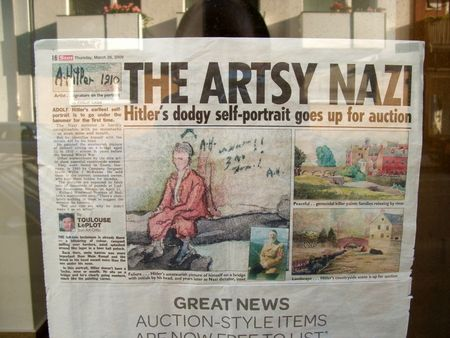


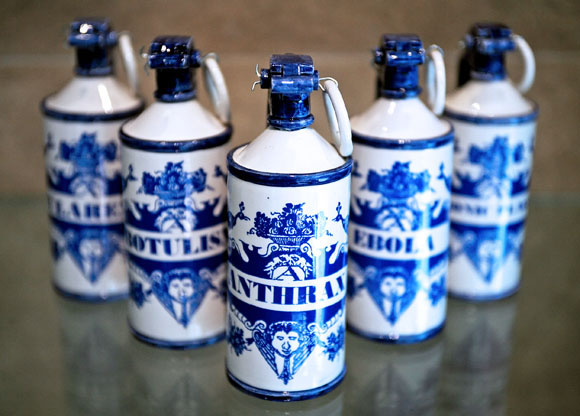


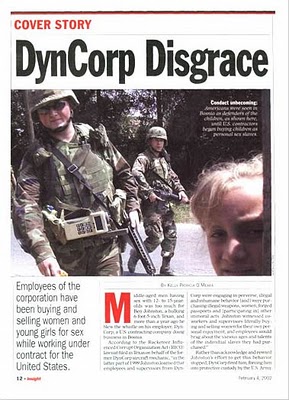
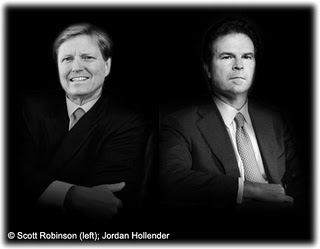

http://twitter.com/#!/ce399fascism
http://twitter.com/#!/ce399research
Is sexism a european thang, or just a male thang? Rodin locked up his wife because she was a better artist (and person) than he.